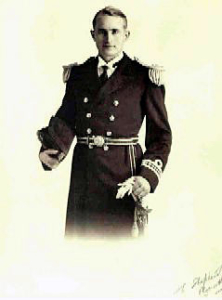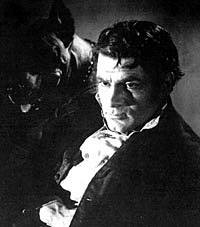Captain Courageous
Geoffrey Alexander Rotherham, known as “Hank”, was born at Darenth, Kent, UK on 31st December 1906, and went to Dartmouth as a cadet in 1920.
Rotherham first fell in love with Canada in the 1920s, when he travelled from England to Esquimalt by ship and train to join the cruiser Durban. He met his Canadian wife, Debbie Stairs, in Bermuda and they married in 1937; the couple had three sons and a daughter.
Rotherham served on Iron Duke, one of the last coal-burning battleships, on the carriers Glorious and Furious, and then on the cruiser Apollo. In 1939 he was promoted at the young age of 33 to commander, and appointed to the carrier Courageous.
He was a restlessly adventurous naval officer, best known as the Fleet Air Arm observer responsible for setting in motion the hunt for the German battleship Bismark in 1941.
For a few months in 1939, Rotherham flew in a motley collection of aircraft used for trial purposes at Lee-on-Solent, Hampshire, UK. Among his fellow pilots were Ralph Richardson, Laurence Olivier, and the ex-Imperial Airways pilot Eugene Esmonde, who later received the Victoria Cross (VC) and Distinguished Service Order (DSO).
Rotherham served briefly in the British Admiralty but thirsted for action. He soon attached himself as Air Staff Officer on an expedition to Dakar, Senegal, in 1940. The expedition, aimed at setting up a Free French base in Africa, collapsed.
Rotherham later became a liaison officer, carrying out much of the aerial reconnaissance for the campaign himself. Crated Blenheim bombers were assembled, and he conducted negotiations with the Free French leaders. For all this he received the Order of the British Empire (OBE) in 1941.
For a year, Rotherham was Commanding Officer, Naval Air Station Twatt, a village 15 miles from Hatston, UK. He then went on to join the staff of the Eastern Fleet carrier force and helped plan the seizure of Madagascar. He directed the fleet’s aircraft to sink the d’Entrecasteaux and, when he boarded the wreck, captured important French codebooks.
In May of that year, Rotherham was in the Orkney Islands when news came that the Bismarck and the cruiser Prinz Eugen had sailed from the Baltic. The weather made flying impossible for several days. On his own initiative, Captain St John Fancourt, the senior naval officer, planned a Fleet Air Arm attack on the German vessels, then thought to be at Bergen, Norway. Rotherham immediately volunteered for a reconnaissance of the Norwegian fjords in a Maryland bomber. In low cloud and strong winds, sometimes flying as low as 50 feet, both to avoid German radar and to be able to estimate wind speed accurately, Rotherham navigated the Maryland to a perfect landfall. Then, though under heavy fire, it searched the fjords so thoroughly that he was able to signal on an emergency frequency: “Battleship and Cruiser have left”.
The signal set in motion the hunt for the Bismarck, which led first to the loss of HMS Hood and then the destruction of Bismarck. The Commander-in-Chief signalled his personal thanks and hearty congratulations on a daring and successful reconnaissance. Rotherham was awarded an immediate DSO.
For the next two and a half years he commanded the Royal Naval Air Station at Katukurunda, Ceylon (now Sri Lanka), which rapidly became the Royal Navy’s largest airbase and an important staging post in the war against Japan. The station afforded plenty of scope for Rotherham’s leadership and resource. He was given a sea-going command on the escort carrier Trouncer, intended as the flagship for an assault on Malaya. VJ-Day overtook his preparations, but Trouncer was sent east anyway and, on 29th September 1945, off Port Said, Egypt, Rotherham rescued 450 passengers and crew from the fiercely burning ship Empire Patrol.
In 1946, after five years in the wartime rank of acting captain, Rotherham decided to accept an appointment as Director of Naval Aviation, on loan to the Royal Canadian Navy. By 1949, Rotherham had been in Canada longer than any other country since 1929, and it was natural that he should retire there. He joined the RCNVR and was active in the Naval Officers’ Association. He took pride in having been awarded the Coronation Medal by Ottawa.
He kept up with his old friends and naval news and published an autobiography, “It’s Really Quite Safe” (1985).
Rotherham died on 8th December 2002, aged 95.


 CFB Esquimalt Naval and Military Museum
CFB Esquimalt Naval and Military Museum CFB Esquimalt Naval and Military Museum
CFB Esquimalt Naval and Military Museum CFB Esquimalt Naval and Military Museum
CFB Esquimalt Naval and Military Museum CFB Esquimalt Naval and Military Museum
CFB Esquimalt Naval and Military Museum CFB Esquimalt Naval and Military Museum
CFB Esquimalt Naval and Military Museum CFB Esquimalt Naval and Military Museum
CFB Esquimalt Naval and Military Museum CFB Esquimalt Naval and Military Museum
CFB Esquimalt Naval and Military Museum CFB Esquimalt Naval and Military Museum
CFB Esquimalt Naval and Military Museum CFB Esquimalt Naval and Military Museum
CFB Esquimalt Naval and Military Museum